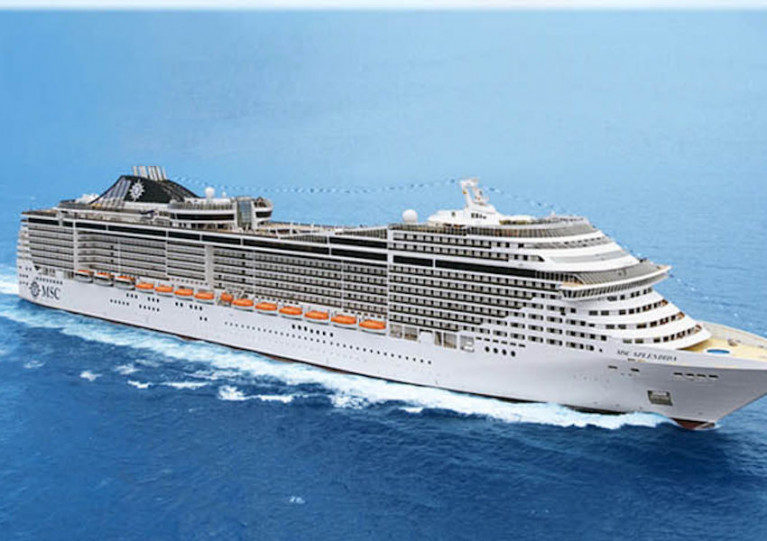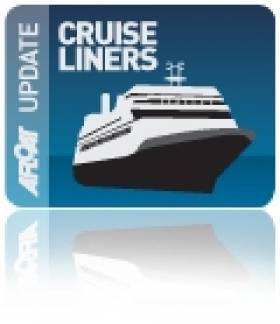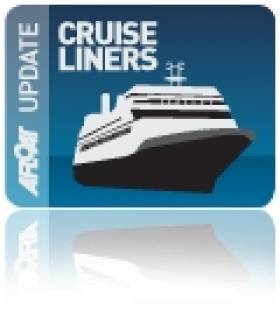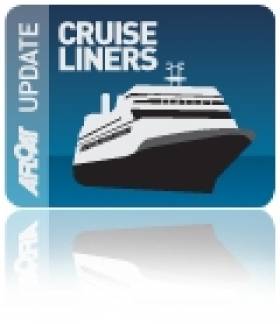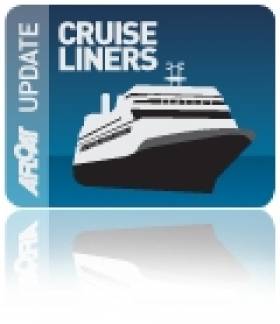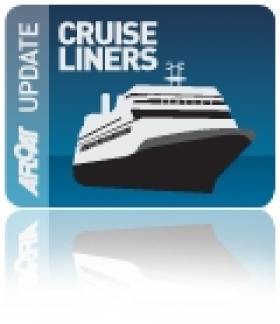Displaying items by tag: MSC Splendida
Cruise Liner Bound For Belfast Rerouted From Italian Ports Over Nationwide Covid-19 Lockdown
A cruise liner bound for Belfast in May has had its itinerary changed to avoid two upcoming port calls in Italy, following that country’s extraordinary national lockdown measures to control the coronavirus pandemic.
According to the Belfast Telegraph, the MSC Splendida was due to dock at Civitavecchia on Saturday 28 March and the following day at Genoa.
However, with quarantine extended to the whole of Italy by its government this past Monday (9 March), MSC Cruises has rerouted the ship to instead dock in Marseille in 28 March and Barcelona on 29 March.
The MSC Splendida is expected to arrive in Belfast Lough on Friday 1 May via Hamburg.
The Belfast Telegraph also reports that a major cruise operator hit hard by Covid-19 outbreaks, and which was due to bring 5,000 people to Belfast on Friday 8 May, has suspended operations for the next eight weeks.
Princess Cruises, whose Diamond Princess in Japan and Grand Princess in California were subjected to quarantine, also operates the Regal Princess — which is at present approaching Cozumel in Mexico to end its current voyage.
#RepeatReverseRole – MSC Splendida repeated a reverse docking call to Dublin Port today following the same unorthodox berthing procedure of only the previous week, writes Jehan Ashmore.
Operators of the largest ship ever to dock in the capital, MSC Cruises cited their decision to call to Dublin Port having cancelled a scheduled anchorage call off Dun Laoghaire Harbour for today was due to positive passenger feedback been so close to the city, allowing more time to spend ashore.
In fact the visit of the 3,200 capacity MSC Splendida is much longer than the average port of call at almost a total of 31 hours berthed alongside Alexandra Basin West. The longest quay for such massive cruiseships was reserved for the port's longest ever cruiseship at 333m. As such this prevented her to swing in the confines of the turning circle hence an arrival astern to berth in the basin.
She departs from the basin's Ocean Pier at 23.00 tonight.
The decision to change Dublin Bay destination is a double blow to Dun Laoghaire Harbour Company which expressed dismay as this was the second time MSC Cruises have cancelled. The massive cruiseship was to launch the season on 11 May. This would of involved the transfer of passengers ashore by tenders to and from the harbour.
Instead the first caller of a now reduced record-breaking season of 22 callers to Dun Laoghaire was left to Princess Cruises 3,600 passenger Royal Princess which made her maiden call off the harbour last week.
It will be a case of deja-vu not just because of today's MSC Splendida's repeat reverse call but that Royal Princess is to cancel her next call this Sunday off Dun Laoghaire. She is to steer a course across the bay for a first call to Dublin Port with an arrival time from 05.30.
In the meantime, tonight the 3,900 passenger capacity MSC Splendida is to depart at 23.00 and head northwards to Greenock Cruise Terminal on the Clyde.
The Scottish terminal is where Queen Mary 2 docked today having made her second call in as many years yesterday off Dun Laoghaire Harbour bringing up to 3,000 passengers to visit the borough and beyond.
#SplendidaSwitchPorts - MSC Cruises operators of the massive MSC Splendida have confirmed that the ship will be back for a second visit to Dublin Port at 4.30am this Thursday, May 21.
Following MSC Splendida's debut call last week (Monday, May 11) as previously reported on Afloat.ie, the cruiseship had been scheduled to anchor offshore at Dun Laoghaire, but has now changed its plans to re-enter Dublin Port.
"Getting MSC Splendida into Dublin Port is no mean feat," said Giles Hawke, MSC Cruises executive director for the UK and Ireland.
"But judging by the amazing feedback we have received, it is certainly an effort worth making. Our cruise guests love the convenience of being able to disembark quickly and make the most of their time in such a beautiful and friendly city."
MSC Splendida made maritime history as the largest cruise ship ever to dock in Dublin Port during her recent visit, and staff were "blown away" by the amount of people lining the Liffey to wave it off, Hawke added.
Having carried out preparations for the anticipated visit, however, the Dun Laoghaire Harbour Company expressed dismay over the change of plans.
"We are disappointed and surprised that the MSC Splendida has transferred its call to Dublin Port, considering that this was a scheduled anchorage call to Dun Laoghaire Harbour," said Captain Simon Coates, Habour Master, Dun Laoghaire Harbour.
Dun Laoghaire had expected to welcome 21 cruise ships this season; while Dublin Port is set to welcome 83.
For much more The Independent has a report here.
Afloat.ie adds that Royal Princess (see previous report) which is even larger than the MSC Splendida was due to make a return call to Dun Laoghaire this Sunday, however according to the Dublin Port cruise schedule she is also instead to call to the capital on Sunday.
The Royal Princess had been due to make a repeat anchorage call off Dun Laoghaire Harbour that same day next weekend though this will be her first call to Dublin Port.
Royal Princess at 142,000 tonnes is in fact larger than MSC Splendida and will so outpace last week's record for the largest ever ship of any type to visit Dublin Port. As for length, MSC Spendida still holds that title as the longest cruiseship ever at 333m to enter the port.
Afloat.ie will have more to add to this latest developmment.
In the meantime, Dun Laoghaire Harbour Company can look forward tomorrow (May 20) to the visit of Cunard Line's flagship Queen Mary 2, the cruise-liner having made her debut off the south Dublin Bay port in 2013.
#WatchSplendida – MSC Splendida's sheer size currently occupies almost the entire Ocean Pier quay within Alexandra Basin, where the largest and longest cruiseship in the history of Dublin Port docked today, writes Jehan Ashmore.
Towering 18 decks above the port estate and that of Alexandra Basin the main part of the port that accommodates the majority of cruisecallers. This latest record-breaking caller demonstrates how large these ships are and indeed becoming increasingly bigger!
Listed below is more detailed information of the 2009 built cruiseship completed for MSC Cruises from the yard of STX France in Saint Nazaire.
Splendid's Statistics
Gross tonnage 137.936 tons
Number of passengers 3.247 (on double basis)
Crew members About 1.370
Number of cabins 1.637, incl. 43 for guests with disabilities or reduced mobility
Length/Beam/Height 333,30 m / 37,92 m post panamax / 66,80 m
Decks 18, incl. 14 for guests
Maximum speed 22,99 knots
Average speed 18 knots
So Where to Watch the Splendida...
With all that to take on board or even from the perspective as of a spectator ashore...where are the best places to observe this latest instalment to Dublin Port representing the global cruise industry.
The best vantage point is ideally along the Great South Wall which celebrated its 300th anniversary in which the Dublin Port Company held a conference recently to celebrate the decision to built the wall. Studies from an EIS for the proposed €30m cruise terminal formed as a major part in the contents of the conference lectures.
Also included in the conference was the beach on Bull Island which too will offer views as the ship departs behind the North Bull Wall that forms the other boundary of the port channel.
What about the open stretches lining the 'Splendid' horse-shoe shaped bay notably along Sandymount Strand that forms such a unique part of this amenity of a European capital.
From here you will be able to see the 18-deck ship glide above the port's skyline as it heads down the channel along the Great South Wall and beyond the Poolbeg Lighthhouse entrance.
Or if out jogging and walkers alike can look forward to either the pierheads at Dun Laoghaire Harbour giving another view as she progresses underway in the bay. Dun Laoghaire Harbour itself is where there are also plans to accommodate such huge cruiseships within the harbour with a purpose built €18m cruise-berth jetty.
In fact the MSC Splendida was originally due to make an anchorage call today off Dun Laoghaire Harbour with passengers tendered ashore, however she is scheduled to call on the 21st May.
Noting that the even larger! Royal Princess of 141,000 tonnes with 3,600 passengers and 1,300 crew is to call offshore of Dun Laoghaire tomorrow (noted latest update on ETA is 6 am in the morning). The 2013 built Princess Cruises ship will instead launch the season as the first of a record 21 cruiseships due in the majority to anchor off the south Dublin Bay harbour.
The arrival of Royal Princess given her closer anchorage call should arguably be more impressive than MSC Splendida particularly given the vantage available from coastlines south of Dun Laoghaire.
#DublinCruiseRecord – A historic day for Dublin Port as the biggest ever ship to dock, MSC Splendida of more than 137,000 tonnes and towering 18 decks called this morning with the massive cruiseship entering the port 'stern' first or in reverse, writes Jehan Ashmore.
The Mediterranean Shipping Company's (MSC) Cruises 3,200 passenger / 1,370 crew cruiseship had sailed overnight from Greenock, on the Firth of Clyde.
Her call is another leap for the port as Grand Princess in 2004 marked a major maritime milestone as the first ship to exceed 100,000 tonnes complete with a gravity defying disco.
The MSC Splendida can boast too as she features Turkish baths!... offering the utlimate in luxury but only to those who join the MSC Yacht Club, an excusive ship within a ship experience.
MSC Splendida's maiden call to Dublin Port also became the longest cruiseship to visit at 333 metres as she ranks as the 11th longest in the world. These impressive dimensions have pushed the port's operational limits as previously explained today on Afloat.ie and below.
Currently the port can only handle ship lengths of up to 300m which is why the 'Fantasia' class MSC Splendida could not sail up the channel normally, nor be able to use the turning circle prior to entering Alexandra Basin due to the confined quay layout space on such a longer ship.
Instead, MSC Splendida was skilfully edged astern or backwards within Alexandra Basin to berth No.33. This sees the bow already face the River Liffey in readiness for a straightforward departure this evening (from 7 pm) from Ocean Pier that separates both Alexandra Basins (West where docked) and that of neighbouring East basin.
However, back in 2002, the same procedure of bringing a cruiseship in reverse through Dublin Port's entrance involved Royal Caribbean Line's Brilliance of the Seas of 90,000 tonnes that docked also at Alexandra's berth No.33. At the time the brand 'Millennium' class newbuild was also the longest cruiseship to Dublin Port at 295 metres.
Likewise of MSC Splendida, this required a lot of preparation prior to handling such a vessel despite then there being leeway in terms of length for the 'Brilliance' to swing in the turning circle leading into Alexandra Basin. It is understood however that during the call then more than a decade ago, that there was insufficient depth for the 'Brilliance' notably on the river side outside the basin to allow for safe navigation of the turning circle into Alexandra Basin.
On a related note, further dredging would be required as DPC's proposed Alexandra Basin Redevelopment (ABR) Project and associated EIS is currently under review with An Bord Pleanala. The ABR is intended to transform phase one of the port Masterplan so to allow larger and deeper drafted ships of all types, including the world's largest cruise ships, to routinely call to Dublin Port.
In the case of cruise ships, they will berth upriver at a proposed €30m double-cruise berth terminal next to the East Link Bridge along the North Wall Quay Extension. The second berth would be within Alexandra Basin which would be accessed by an expanded turning circle that faces the Poolbeg Yacht & Boat Club Marina.
The proposed terminal would handle the world's top ten largest cruise liners, including those such as Royal Caribbean Line's 360m long Allure of the Seas. This is a mega 'Quantum' class cruiseship of 168,000 tonnes and carrying almost 5,000 passengers.
As previously reported, only the Port of Cork's cruise terminal at Cobh can handle these much larger cruiseships, though the port company are not expecting such callers until the 2017 cruises season.
Biggest Ever Cruiseship to Dublin Port In Advance of Dun Laoghaire's Largest Passenger Call
#DublinsBiggestShip – Dublin Port is to have the biggest ever ship of any type to call when cruiseship MSC Splendida of all 137,926 gross tonnes is to make her Irish debut instead of anchoring firstly offshore of Dun Laoghaire Harbour, writes Jehan Ashmore.
According to Dublin Port Company CEO Eamon O'Reilly, who was speaking at the recent Dublin Bay Conference which was held in the Gibson Hotel overlooking the site of the proposed €30m cruise terminal, the MSC Splendida is to call on 11 May, the same day original scheduled for her anchorage call off Dun Laoghaire.
It is not known why the huge 18-deck 'Fantasia' class 333m long cruiseship has swapped ports, though there are many variables in the shipping industry over the re-scheduling of vessels.
Having said that MSC Splendida is to call offshore of Dun Laoghaire Harbour on the 21st May of the following week. When she does the 3,900 passenger accommodation vessel makes her the largest in capacity terms of this seasons record breaking 22 cruiseships calling within the harbour and anchoring offshore.
Added to the MSC Splendida's tourists will be a crew of around 1,370 which is close to that of the 1,500 passenger former Dun Laoghaire-Holyhead fast-ferry HSS Stena Explorer.
This leaves another massive cruiseship, Royal Princess of 142,714 tonnes (see, Belfast's biggest caller 2014) to become the first caller this season for the Dun Laoghaire Harbour Company when she takes anchorage in south Dublin Bay on 12th May. The 330m cruiseship has a 3,560 passenger capacity.
Another yet repeat caller is Cunard's Line's flagship cruise 'liner' Queen Mary 2 (QM2) which at 151,000 tonnes and 2,600 passengers is due to call offshore on 20th May, the day before MSC Spendida's inaugural call.
The QM2 is 61.9m high while the MSC Splendida is even higher towering at almost 70m. Such-sized ships and larger could enter Dun Laoghaire Harbour as proposed by the €18m single cruise-berth in which the DLHC are understood to lodge this month a planning application accompanied by an Environmental Impact Statement (EIS) to An Bord Pleanala.
MSC Splendida is operated by MSC Cruises, the passenger arm of the Mediterranean Shipping Company that run container services to Dublin Port. When she calls, the massive cruiseship is to enter the port entrance astern, this is due to current restrictions of the port layout and the relationship to her sheer size and water depth notably when berthing in the confines of Alexandra Basin. This area of the port forms part of the port's 'Masterplan 2040' as the Alexandra Basin Redevelopment (ABR) reconfiguration project is to cost €200m.
The arrival of MSC Splendida will be a clear demonstration as to why the Dublin Port Company propose the €30m cruise terminal facility. The double cruise-berth facility is to accommodate such ships and those of the next generation mega cruiseships. A decision from An Bord Pleanala over the proposed cruise terminal and associated EIS is already currently underway.
Aside all the focus on cruiseships due to the controversary of potentially having two new cruise terminals in Dublin Bay totalling almost €50m, one could easily forget the real driver of the economy is that of cargoships exporting our trade.
As such increasing larger deeper drafted cargoships also need to enter Alexandra Basin and elsewhere in the port. This is where the rest of the masterplan is to meet the rising demands of the shipping industry coupled with economies of scale and capacity demands as record trade figures are broken and are forecast.


























